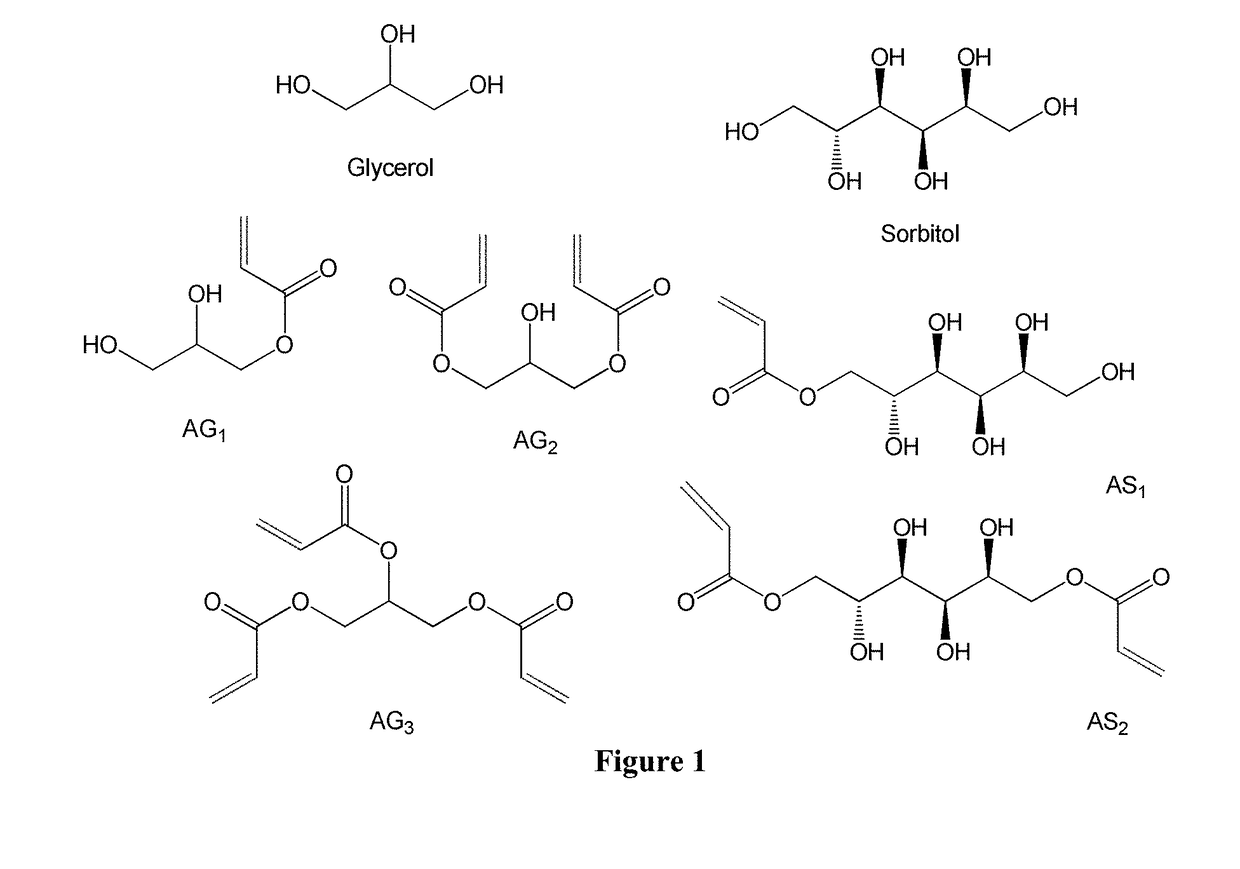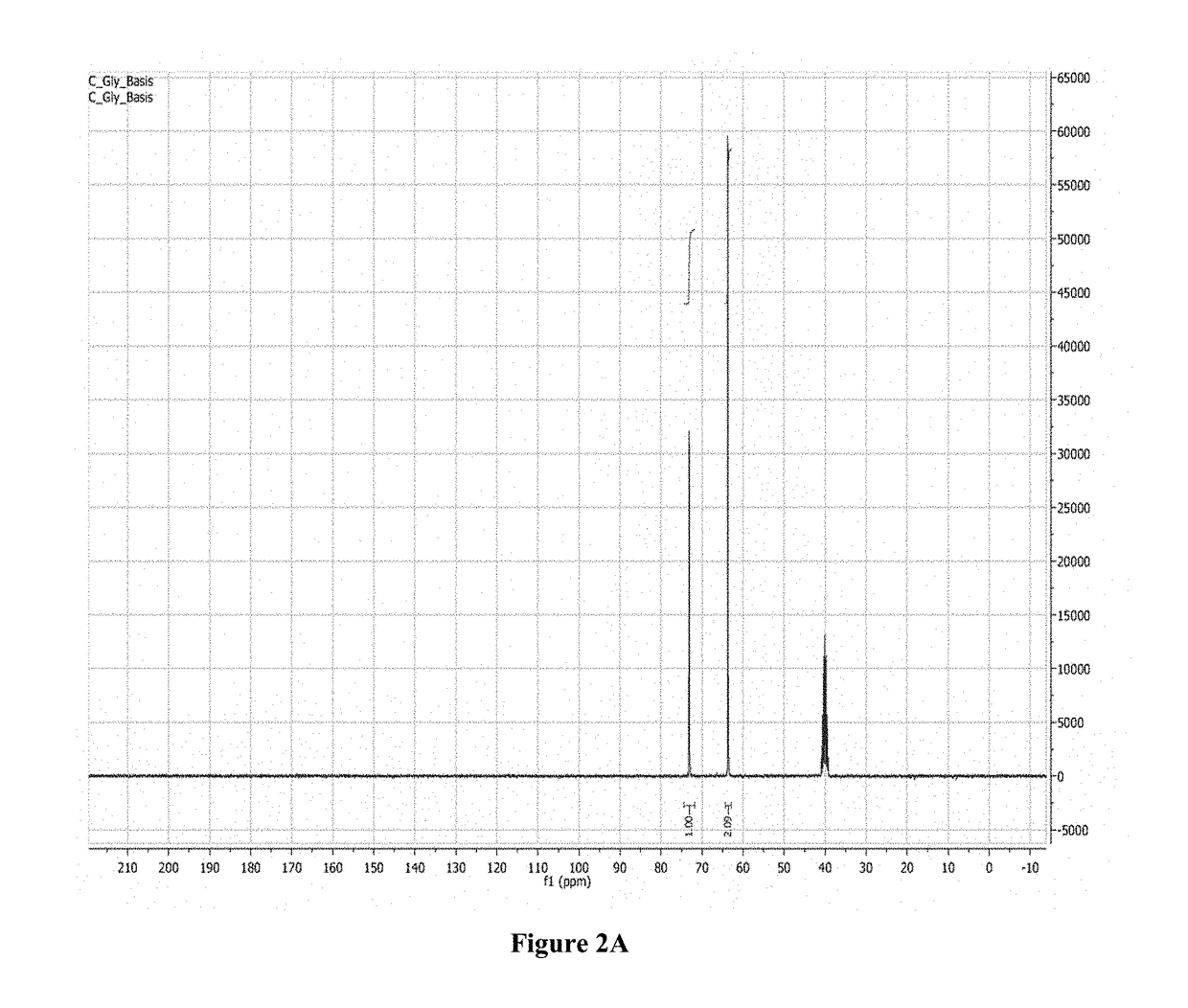Poly(acrylated polyol) and method for making and using thereof as asphalt rubber modifiers, adhesive, fracking additives, or fracking fluids
a polyacrylate polyol and polymer technology, applied in the direction of drilling compositions, transportation and packaging, chemistry apparatus and processes, etc., can solve the problems of low molar mass, low molar weight and conversion rate, and high cost of conventional binders. , to achieve the effect of reducing mix and compaction temperature, high molecular weight and conversion rate, and high molar mass
- Summary
- Abstract
- Description
- Claims
- Application Information
AI Technical Summary
Benefits of technology
Problems solved by technology
Method used
Image
Examples
example 1
of Poly(Acrylated Glycerol) (P(AG)) Via Reversible Addition-Fragmentation Chain Transfer Polymerization (RAFT)
Acrylation of Glycerol
[0158]Glycerol was mixed with hydroquinone (inhibitor, 0.5 wt % of glycerol), thiamine pyrophosphate (TPP, catalyst) in a 0.06:1 mass ratio to glycerol, acrylic acid in a 1.5:1 mass ratio to glycerol, and DMSO in a 1:1 mass ratio to glycerol. The reaction was stirred and bubbled for 20 minutes, and then heated to 90° C. The reaction was allowed to proceed for a minimum of 12 hours, and was ended by cooling to room temperature. The final acrylated glycerol was mixed with cyclohexane to remove DMSO, and was dried overnight on vacuum ovens under room temperature.
RAFT Polymerization of Acrylated Glycerol
[0159]RAFT synthesis was performed in a similar manner to the procedure described in Moad et al., “Living radical polymerization by the raft process—a first update,”Australian Journal of Chemistry 59:669-92 (2006); Moad et al., “Living radical polymerization...
example 2
of Poly(Acrylated Glycerol) (P(AG)) or Poly(Acrylated Sorbitol) (P(AS)) Via RAFT
Synthesis of AGx or ASx
[0168]Synthesis of AGx or ASx can be carried out following the general processes described below.
[0169]Process 1:
[0170]G moles glycerol (sorbitol) are combined with 1-5% by mass hydroquinone or Ethanox 330™ (oxidative inhibitors), triphenylphosphine (TPP) or Amberlyst 15 (catalyst) in a 0.05:1 mass ratio to glycerol, and xG mol of acrylic acid (x is the molar ratio of acrylic acid to glycerol or sorbitol). The mixture is stirred and air-sparged for 36 hours at either 127° C. (TPP) or 120° C. (Amberlyst) Inhibitor and air-sparging (O2) help to reduce auto-polymerization (which will otherwise lead to gelation). After 36 hours, the reaction is terminated by cooling to room temperature. The monomer contains up to 20% of the initial charge of acrylic acid.
[0171]Process 2:
[0172]G moles glycerol (sorbitol) are combined with 1-5% by mass hydroquinone or Ethanox 330™, 0.05:1 mass ratio of ...
example 3
ubber Modification with Polymers Derived from RAFT Polymerization of Acrylated Glycerol
[0185]The glycerol from the biodiesel industry was acrylated and polymerized to different extents, and the resulting materials were then used in the production of asphalt rubber. The asphalt rubber binders “stabilized” by the polymerized acrylated glycerol were tested, and the results were compared to an asphalt rubber (GTR) without any stabilizer, and an asphalt rubber stabilized with Vestenamer®.
[0186]The performances of the asphalt rubber (AR) without any stabilizer, stabilized by the poly(acrylated glycerol), and stabilized by Vestenamer® were compared in terms of rheology, viscosity, and the mixing and compaction temperatures of the AR, the effect on the separation during the AR storage, and the effect in the AR and residual AR.
Materials and Equipment
[0187]Poly(acrylated glycerol)(P(AG)) with different degrees of acrylation and polymerization was prepared based on procedures similarly to the ...
PUM
| Property | Measurement | Unit |
|---|---|---|
| molecular weight | aaaaa | aaaaa |
| Tg | aaaaa | aaaaa |
| Tg | aaaaa | aaaaa |
Abstract
Description
Claims
Application Information
 Login to View More
Login to View More - R&D
- Intellectual Property
- Life Sciences
- Materials
- Tech Scout
- Unparalleled Data Quality
- Higher Quality Content
- 60% Fewer Hallucinations
Browse by: Latest US Patents, China's latest patents, Technical Efficacy Thesaurus, Application Domain, Technology Topic, Popular Technical Reports.
© 2025 PatSnap. All rights reserved.Legal|Privacy policy|Modern Slavery Act Transparency Statement|Sitemap|About US| Contact US: help@patsnap.com



